
Price stayed in a trading range this week. Price was able to recover and hold support after dipping below $361--not today. The morning was positive, but by lunchtime investors decided they had indigestion and the selling began. Near the end of the day, price began consolidating and we thought it might rebound. Unfortunately the bottom fell out before the close.
Often we're asked when do the "big guys" trade. Our friend, Tom Bowley used to say on the MarketWatchers LIVE show that the beginning of the trading day is "amateur hour", mostly retail traders. The investment and money managers typically trade late in the day after they've processed the data. This is by far not a hard and fast rule, but it can give us insight into trading like we saw today where the market was up the first part of the day only to be followed by a steep decline in the last 10 to 15 minutes. Our guess is that everyone decided to finish the day selling.
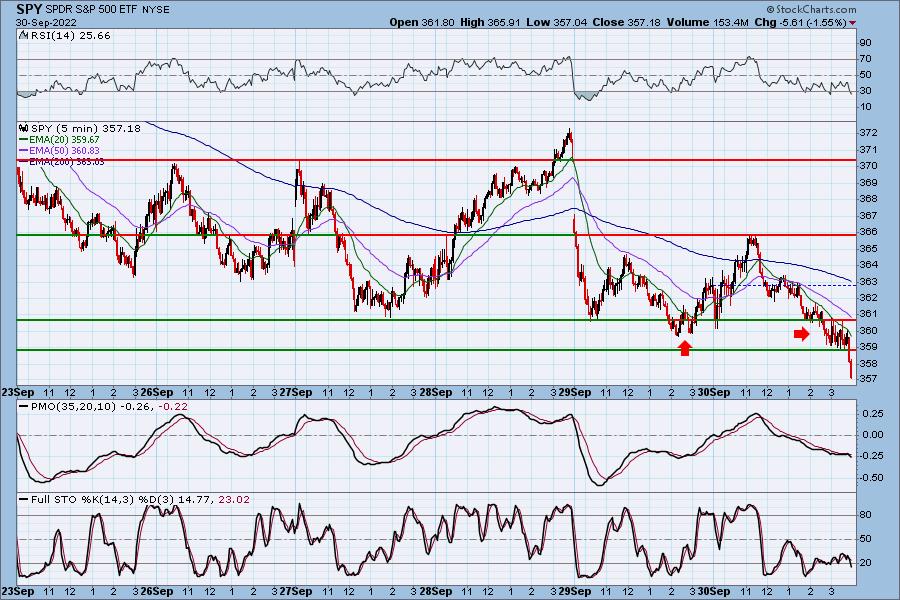
The DecisionPoint Alert Weekly Wrap presents an end-of-week assessment of the trend and condition of the Stock Market, the U.S. Dollar, Gold, Crude Oil, and Bonds. The DecisionPoint Alert daily report (Monday through Thursday) is abbreviated and gives updates on the Weekly Wrap assessments.
Watch the latest episode of DecisionPoint on StockCharts TV's YouTube channel here!
MAJOR MARKET INDEXES
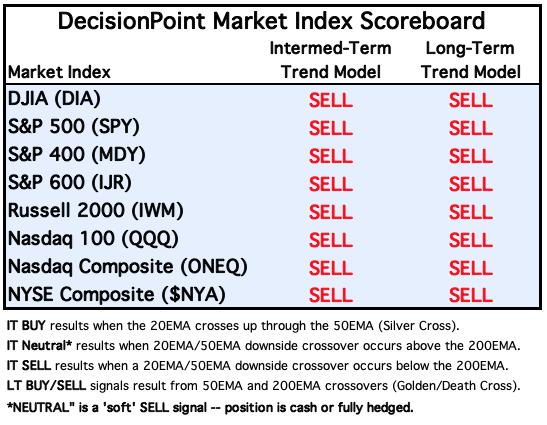
For Today: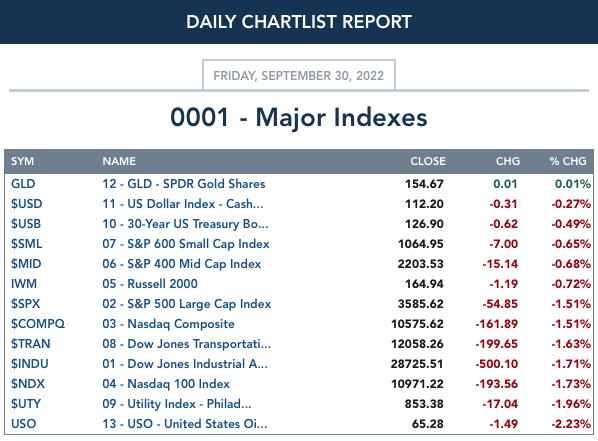
For the Week: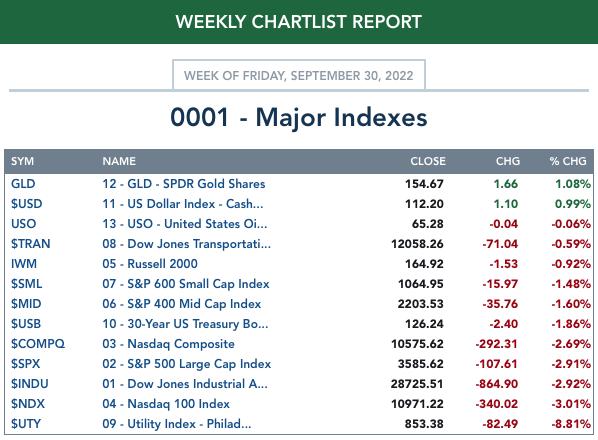
SECTORS
Each S&P 500 Index component stock is assigned to one of 11 major sectors. This is a snapshot of the Intermediate-Term (Silver Cross) and Long-Term (Golden Cross) Trend Model signal status for those sectors.
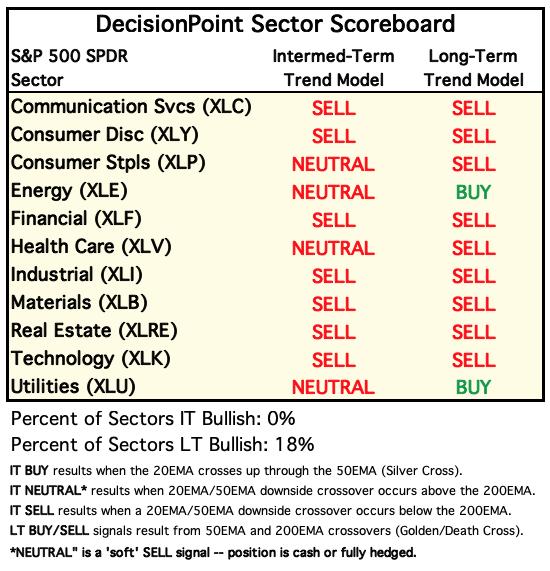
For Today: 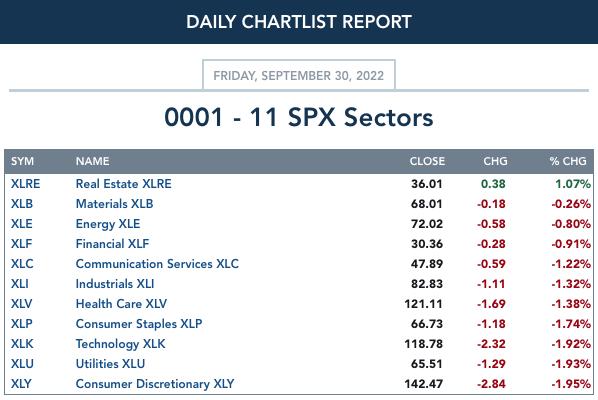
For the Week: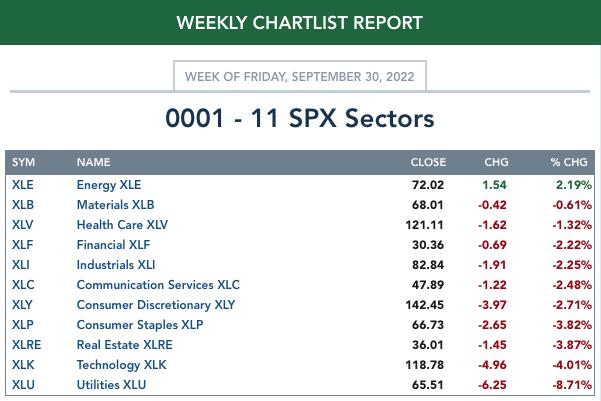
RRG® Daily Chart ($ONE Benchmark):
All sectors are in the very bearish Lagging quadrant. The best way to distinguish strength is to look at the headings. XLK is the only sector with a bullish northeast heading. This sector is not bullish. Remember all of these are in the Lagging quadrant.
The most bearish have a southwest heading, XLP, XLU, XLY and XLV. XLI isn't close behind.
XLC, XLI and XLB would be next given they have westward components to their headings.
XLE, XLRE, XLF are not terribly bearish as they are beginning to hook back around, adding northward components to their headings.
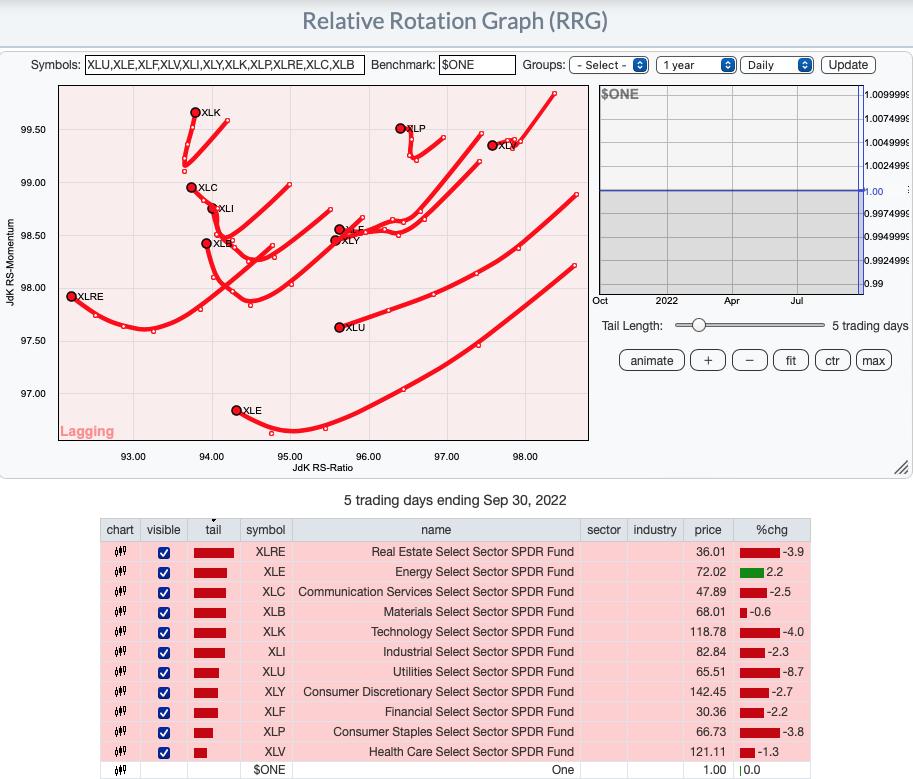
RRG® Weekly Chart ($ONE Benchmark):
The deterioration of this chart began about two weeks ago. Most were in the Improving quadrant and while they were beginning to lose their bullish northeast headings, they were still looking satisfactory.
The only bullish sector is XLE with its strong northeast heading and position in the Leading quadrant.
Most bearish are the sectors traveling southwest; in particular, XLP and XLV have now reached the very bearish Lagging quadrant. XLC, XLB and XLRE are nearest to the Lagging quadrant, but XLI and XLK are far behind.
XLY and XLU are within the Leading quadrant, but are breaking down. XLY is likely to land back in the Improving quadrant, while XLU is likely going to find itself in the Weakening quadrant.
Overall it is a very bearish RRG with the exception of XLE.
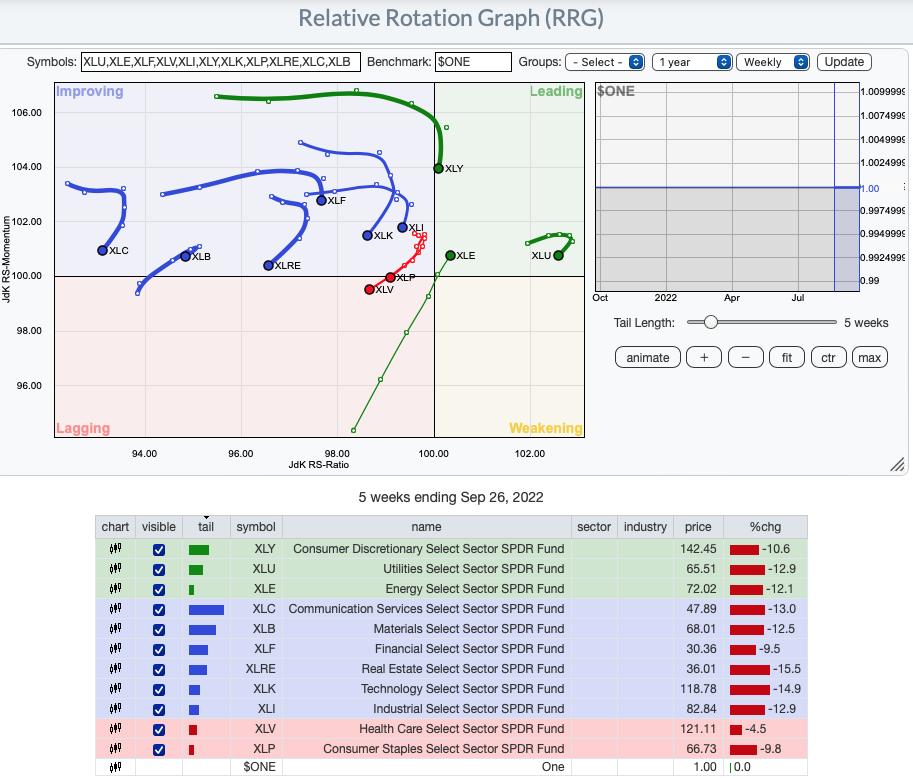
RRG® charts show you the relative strength and momentum for a group of stocks. Stocks with strong relative strength and momentum appear in the green Leading quadrant. As relative momentum fades, they typically move into the yellow Weakening quadrant. If relative strength then fades, they move into the red Lagging quadrant. Finally, when momentum starts to pick up again, they shift into the blue Improving quadrant.
CLICK HERE for an animated version of the RRG chart.
CLICK HERE for Carl's annotated Sector charts.
THE MARKET (S&P 500)
IT Trend Model: BUY as of 8/2/2022
LT Trend Model: SELL as of 5/5/2022
SPY Daily Chart: The reverse flag executed as the market broke down through the support line drawn across the June lows. Today, SPX Total Volume was 144% of the one-year daily average volume, as if holdout bulls finally gave up the ghost. Does this apparent capitulation mark a bottom, or the beginning of a much worse decline?
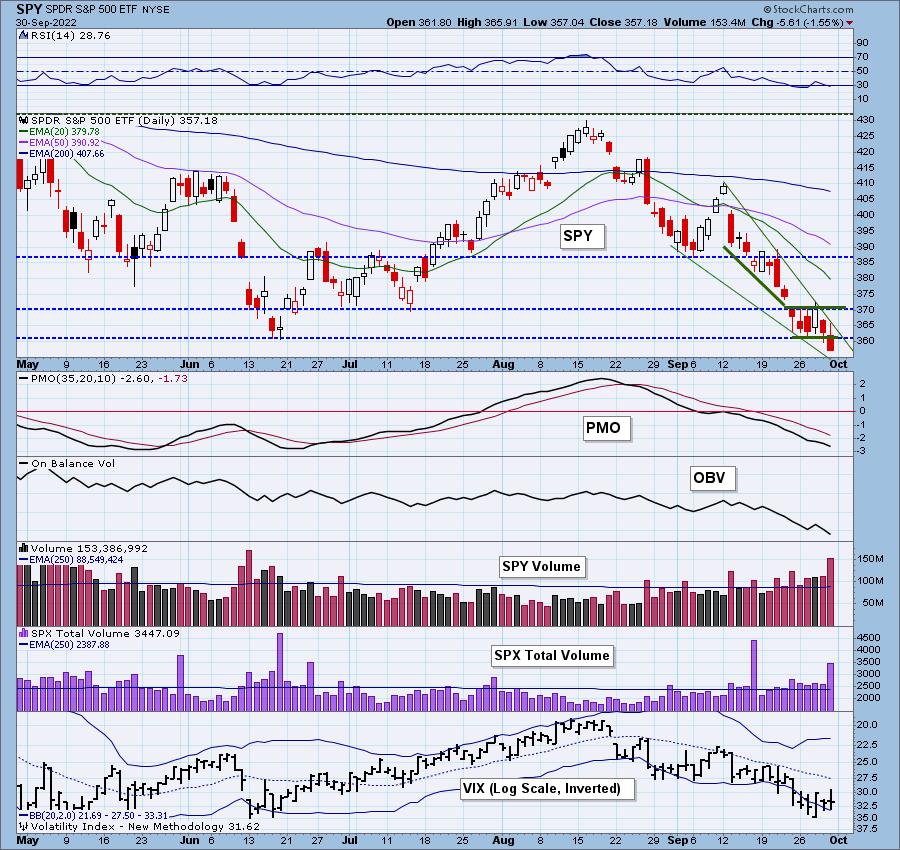
Based on the RSI, PMO and Stochastics, as well as lost support, we vote for the latter.
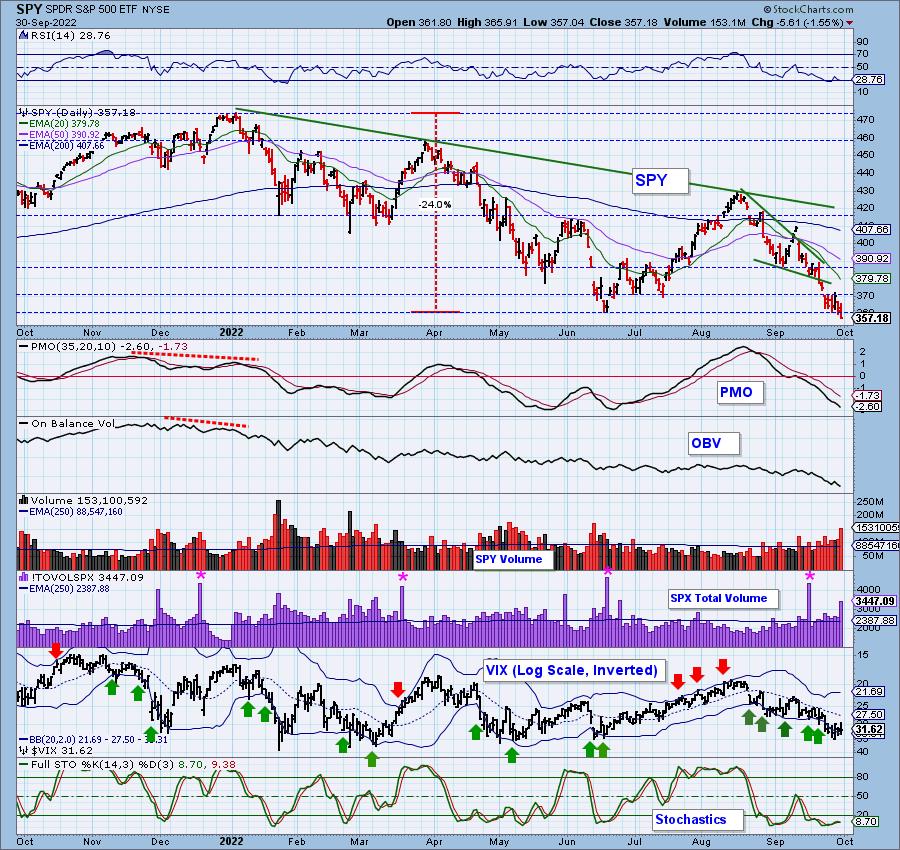
SPY Weekly Chart: The significance of this week's decline is clear on the weekly chart. There is a ray of hope. There is still support available at the mid-2020 top. However, we would look for a test of the next level of support at the 2020 bear market top.
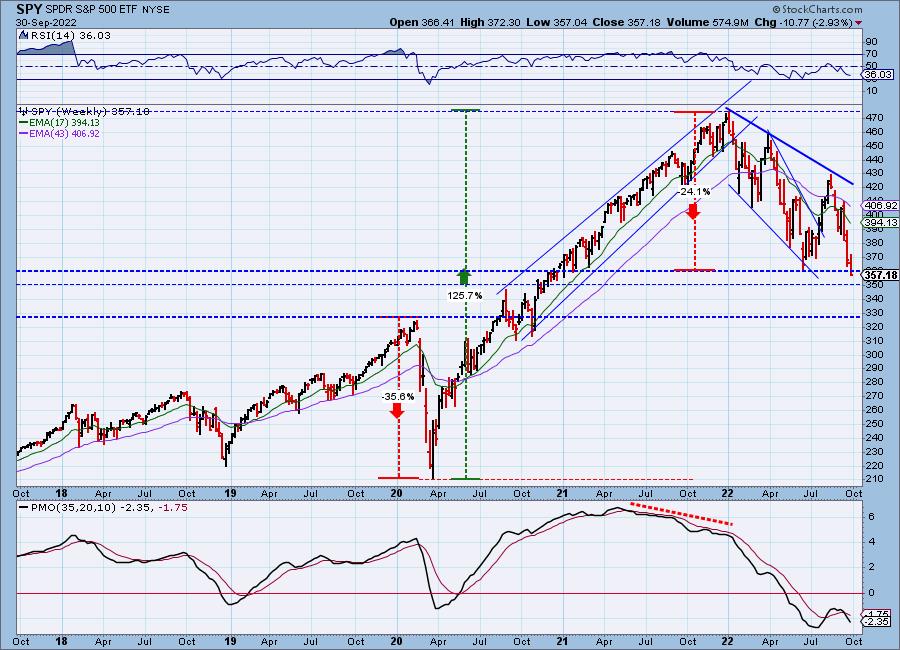
SPY Monthly Chart: The monthly PMO is in full retreat, which gives no hope to those who wish the bear market was over.
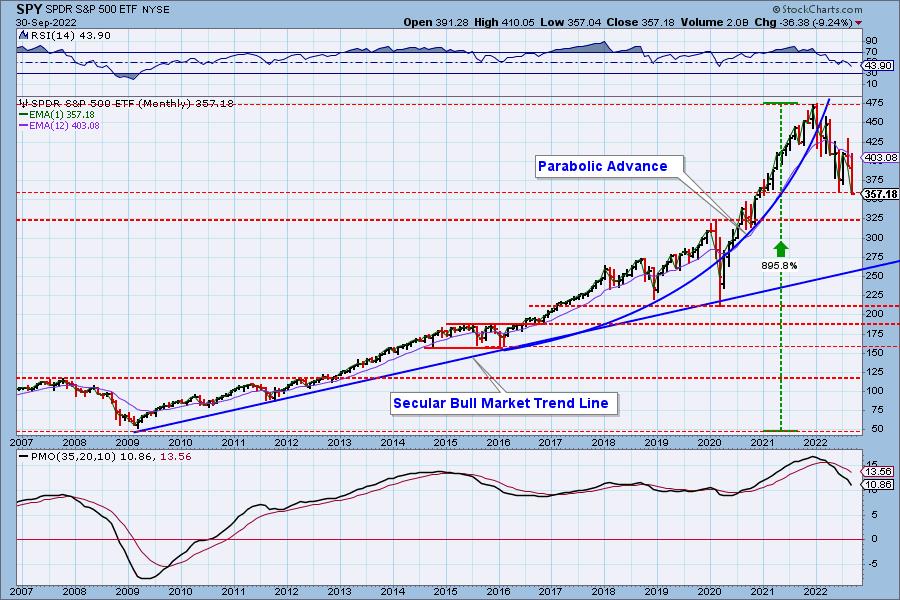
New 52-Week Highs/Lows: The positive divergence on New Lows is lengthening. This chart tells us a bear market rally could be nearing.
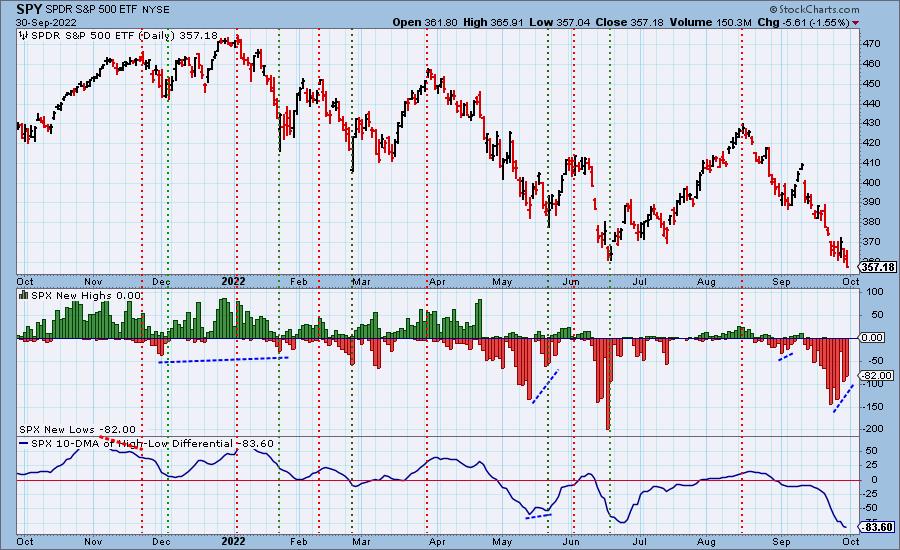
Climax Analysis: After yesterday's downside initiation climax, today we got a downside exhaustion climax. Most climax readings were not especially robust, and the NYSE DOWN/UP Volume Ratio was not climactic. With the price breakdown, we have to wonder if there really was exhaustion and not another downside initiation. Well, for one thing, we got very high SPX Total Volume today, which is an indication of blowout action.
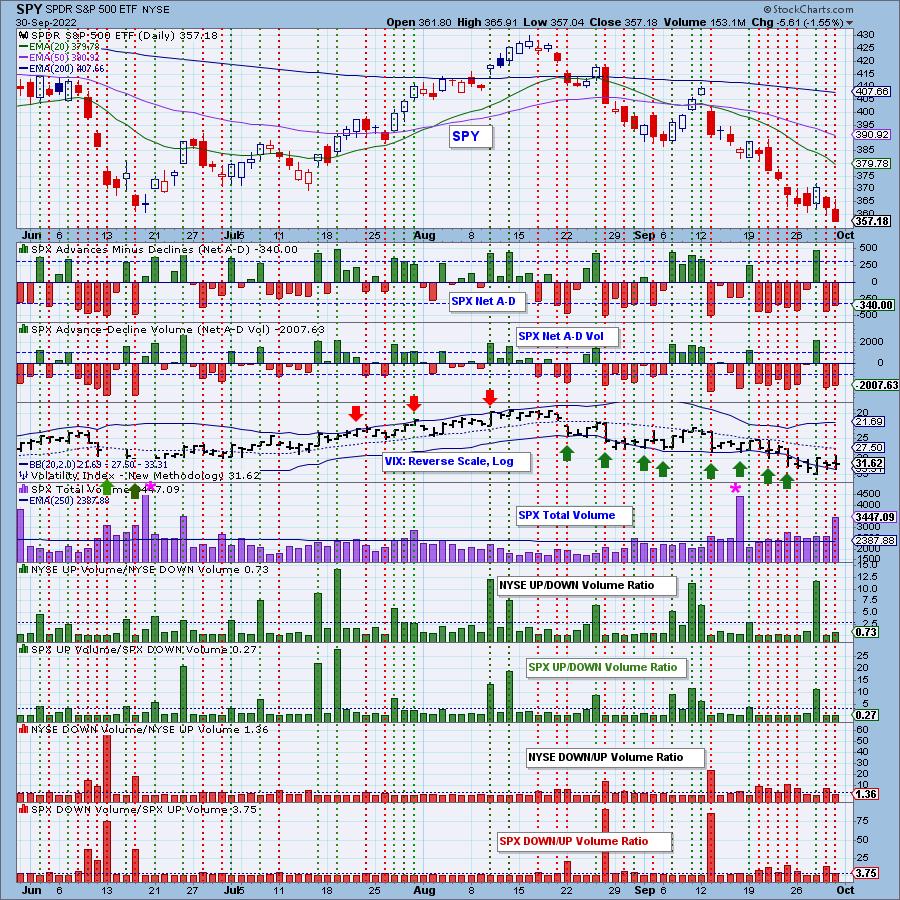
*A climax is a one-day event when market action generates very high readings in, primarily, breadth and volume indicators. We also include the VIX, watching for it to penetrate outside the Bollinger Band envelope. The vertical dotted lines mark climax days -- red for downside climaxes, and green for upside. Climaxes are at their core exhaustion events; however, at price pivots they may be initiating a change of trend.
Short-Term Market Indicators: The short-term market trend is DOWN and the condition is OVERSOLD.
Contracting STOs with oversold readings on %Stocks > 20-day EMA accompanied by %PMOs Rising at a paltry 4%, can give bulls something to hang their hat on.
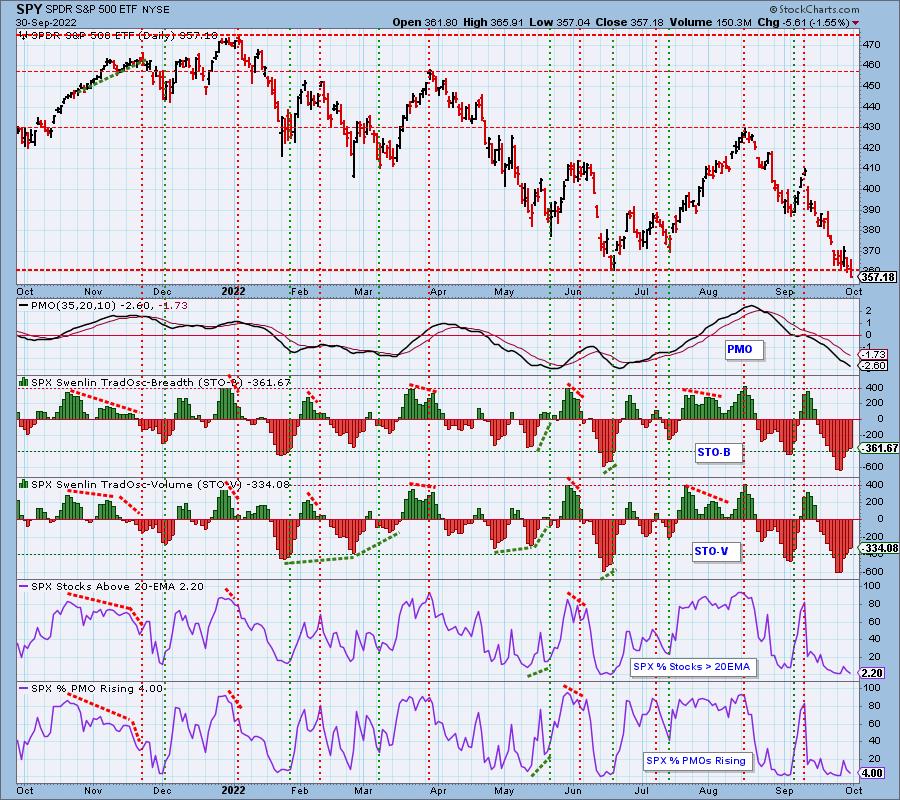
Intermediate-Term Market Indicators: The intermediate-term market trend is DOWN and the condition is EXTREMELY OVERSOLD.
We are finally beginning to see readings rivaling 2020 oversold readings. However, these indicators don't look at all interested in reversing right now. We've been saying that a reversal on these indicators would confirm a rally when we get one. So far, they are confirming the intermediate-term decline.
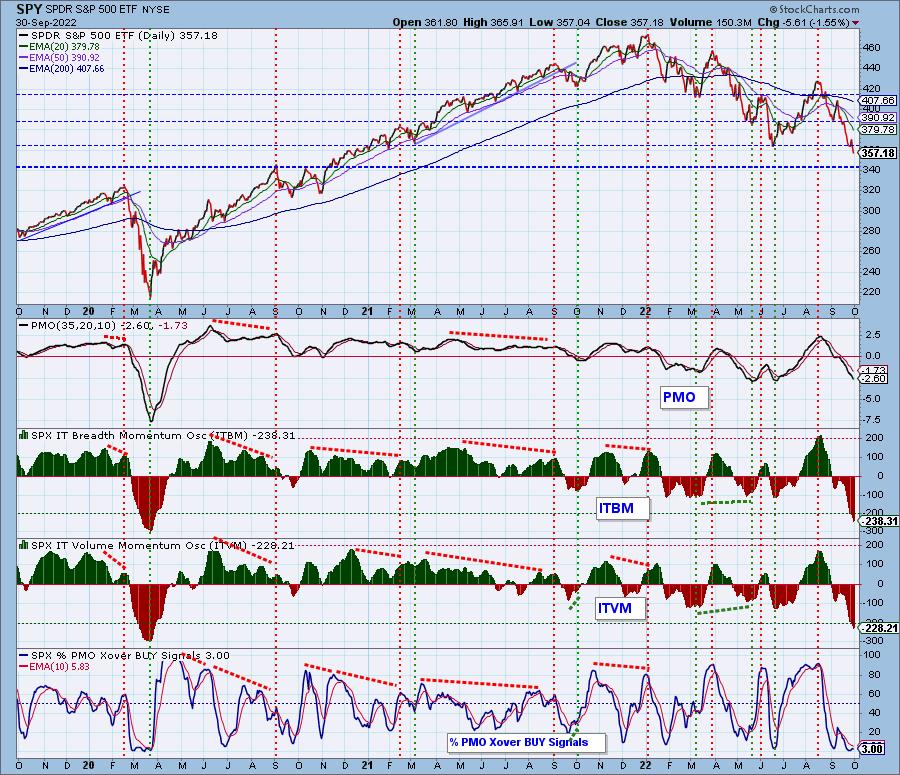
PARTICIPATION and BIAS Assessment: The following chart objectively shows the depth and trend of participation in two time frames.
- Intermediate-Term - the Silver Cross Index (SCI) shows the percentage of SPX stocks on IT Trend Model BUY signals (20-EMA > 50-EMA). The opposite of the Silver Cross is a "Dark Cross" -- those stocks are, at the very least, in a correction.
- Long-Term - the Golden Cross Index (GCI) shows the percentage of SPX stocks on LT Trend Model BUY signals (50-EMA > 200-EMA). The opposite of a Golden Cross is the "Death Cross" -- those stocks are in a bear market.
The following table summarizes participation for the major market indexes and sectors. The 1-Week Change columns inject a dynamic aspect to the presentation.
We have an extraordinarily large bearish bias in the intermediate term for Utilities (XLU) and Energy (XLE). This is caused by the strong rallies they experienced earlier. As a consequence, there are plenty of stocks holding onto their "golden crosses". In the intermediate term, the SCI suffered greatly as those two sectors pulled back in earnest. The silver crosses were decimated. This leaves a large difference between the SCI and GCI. Hence their IT Bias reading at -72 (XLE) and -80 (XLU).
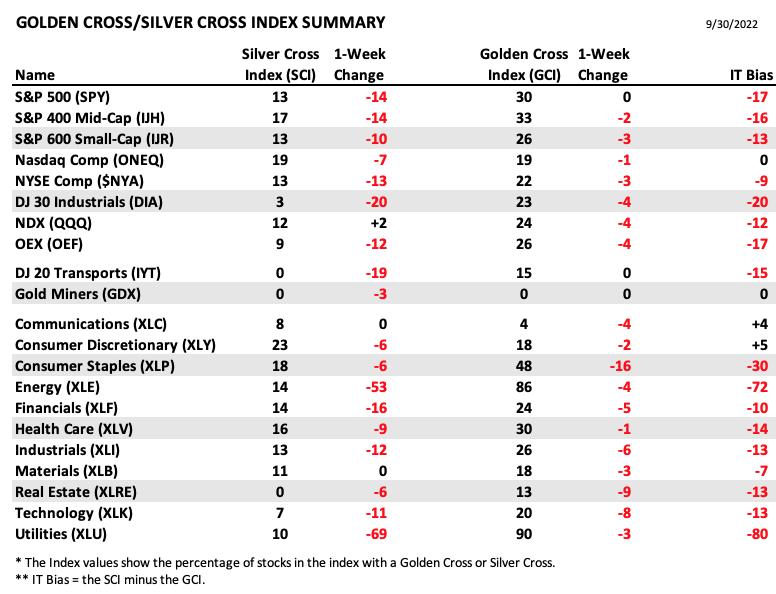
This table is sorted by SCI values. This gives a clear picture of strongest to weakest index/sector in terms of participation.
Utilities (XLU) have fallen from grace with their persistent and steady decline. This put XLU at -69 for the one-week change on the SCI. You'll note Energy (XLE) was far behind at -53.
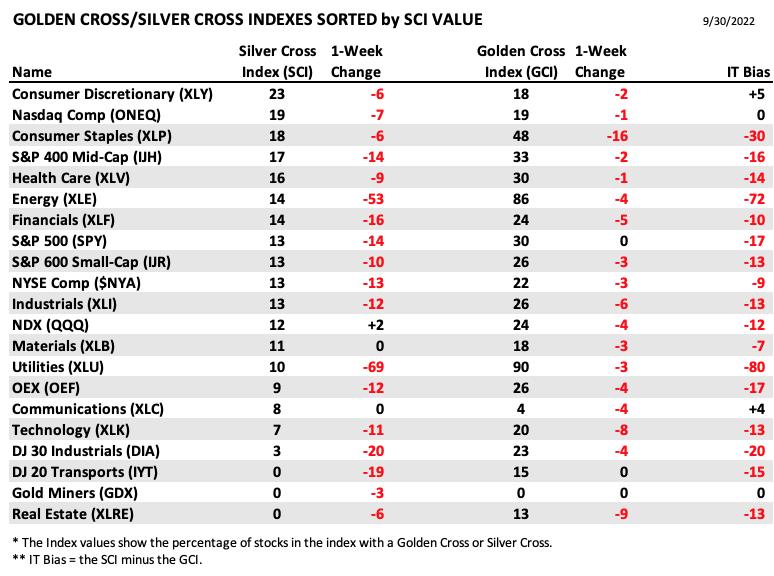
PARTICIPATION and BIAS Assessment: The following chart objectively shows the depth and trend of participation in two time frames.
- Intermediate-Term - the Silver Cross Index (SCI) shows the percentage of SPX stocks on IT Trend Model BUY signals (20-EMA > 50-EMA). The opposite of the Silver Cross is a "Dark Cross" -- those stocks are, at the very least, in a correction.
- Long-Term - the Golden Cross Index (GCI) shows the percentage of SPX stocks on LT Trend Model BUY signals (50-EMA > 200-EMA). The opposite of a Golden Cross is the "Death Cross" -- those stocks are in a bear market.
The bias remains bearish in all three timeframes. The best we can say is that all of the indicators are very oversold.
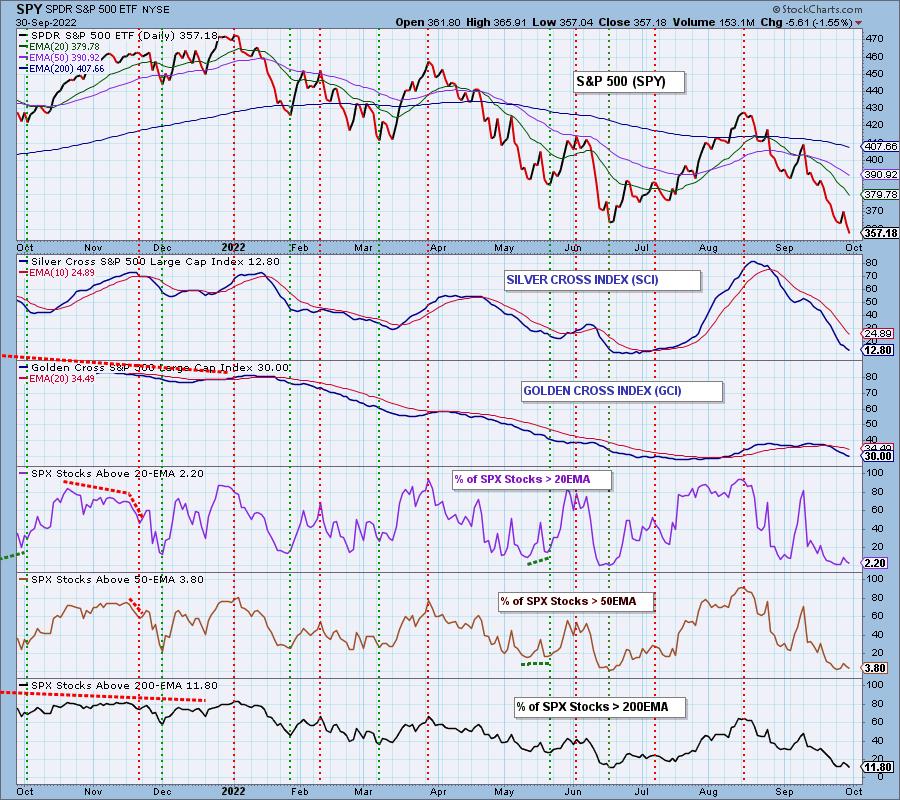
CONCLUSION: The drop below the June low could be a beginning or an end. If we're right that investors are capitulating, we should think of today as a blowout event. We're finally seeing the ITBM/ITVM nearing 2020 oversold readings. STOs are still rising. Today's likely downside exhaustion climax and extremely high Total Volume leave us hopeful. Indicators (and traders) beg for a bear market rally right now, but we should remember that oversold conditions in a bear market are "thin ice". Betting on oversold conditions isn't a good plan of attack. Erin has opted to keep her exposure at 10% and keep her 5% hedges in place going into next week.
Have you subscribed the DecisionPoint Diamonds yet? DP does the work for you by providing handpicked stocks/ETFs from exclusive DP scans! Add it with a discount! Contact support@decisionpoint.com for more information!
BITCOIN
Bitcoin remains range-bound. The indicators are trying to get positive with the sharply rising Stochastics and PMO BUY signal in place, but overall the chart is very neutral suggesting more sideways movement.
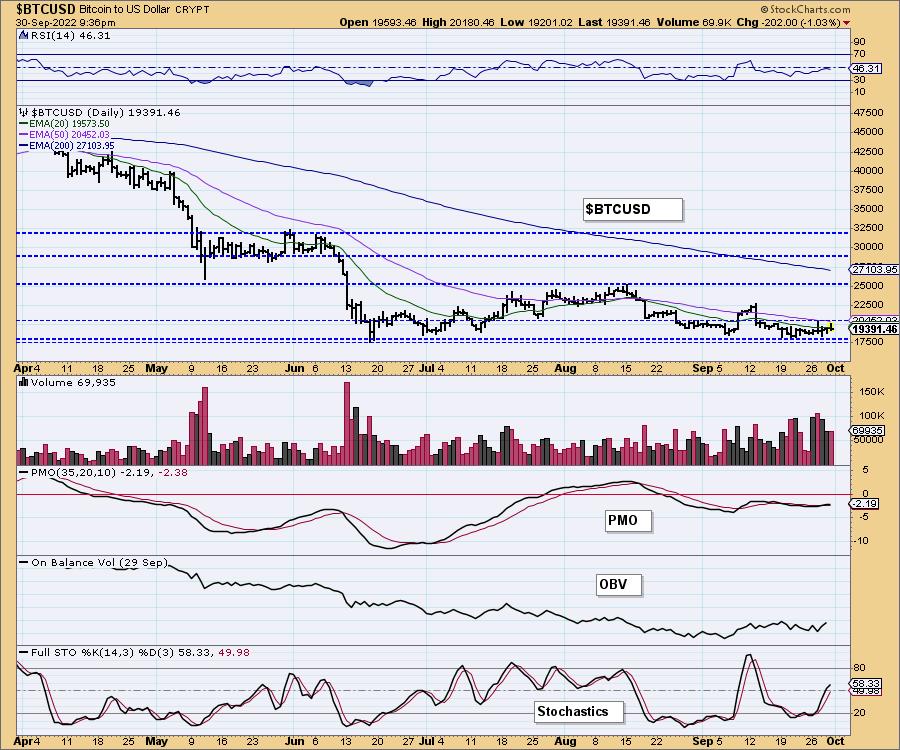
This chart is to show where some of the support/resistance lines come from. A loss of support at $17,500 would suggest Bitcoin would move to the next level of support at $12,000.
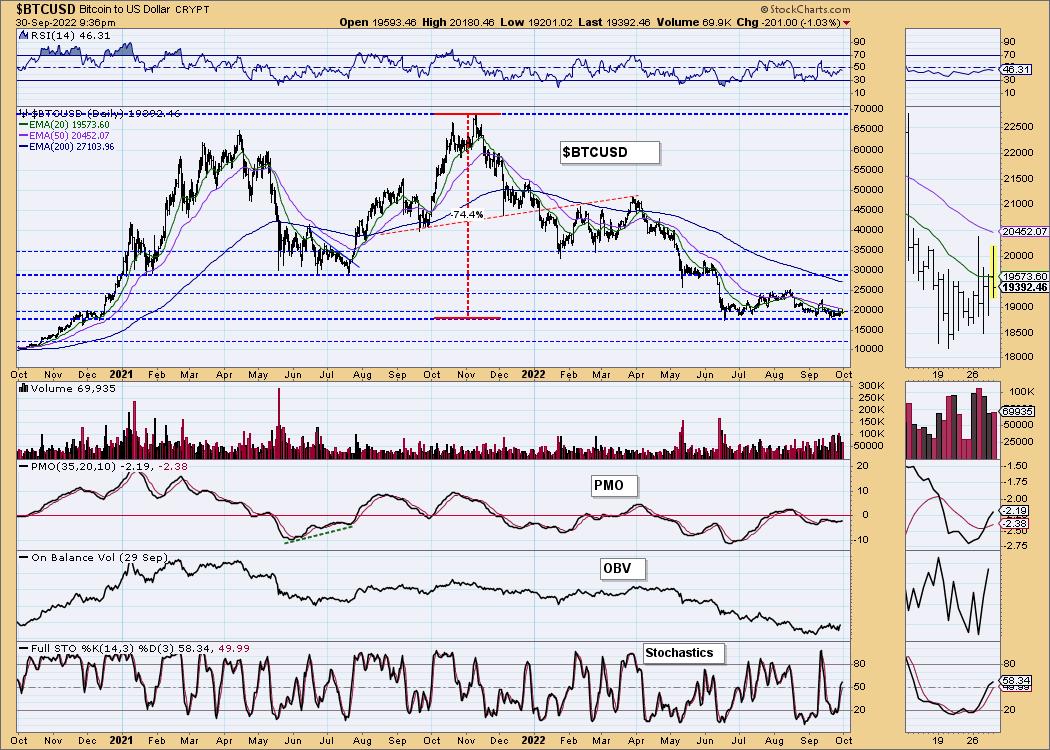
INTEREST RATES
Rates pared back slightly this week, but resumed their rallies to finish the week.
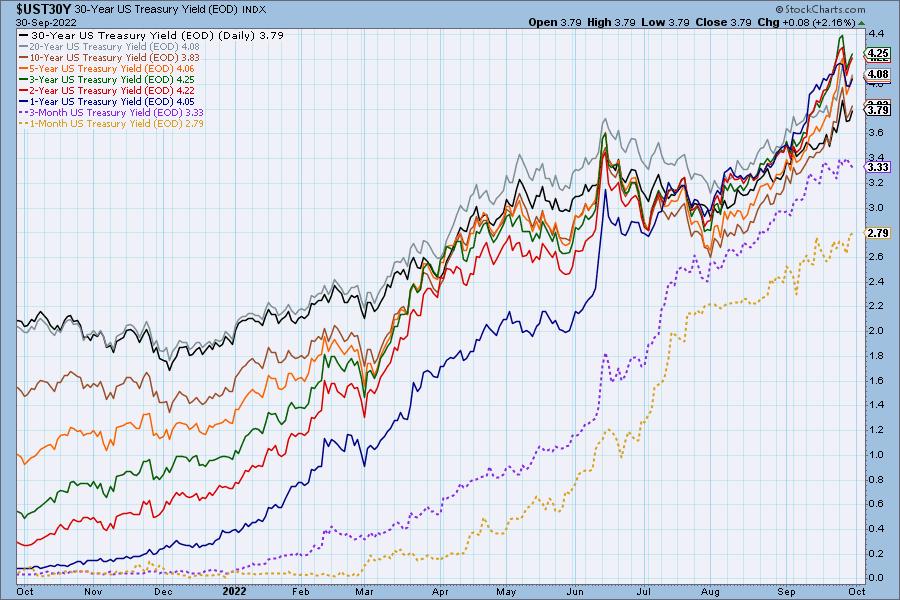
The Yield Curve Chart from StockCharts.com shows us the inversions taking place. The red line should move higher from left to right. Inversions are occurring where it moves downward.
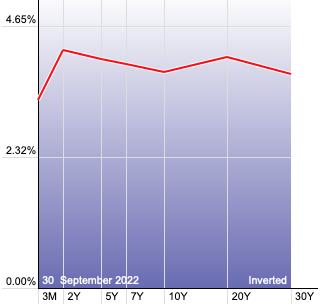
10-YEAR T-BOND YIELD
$TNX had begun to travel parabolically higher so we knew a decline was likely. Sure enough, the parabolic formation broke down. The rising trend hasn't been compromised. The RSI was able to relieve overbought conditions and the PMO has now bottomed above the signal line. Stochastics aren't looking good, but they are in positive territory.
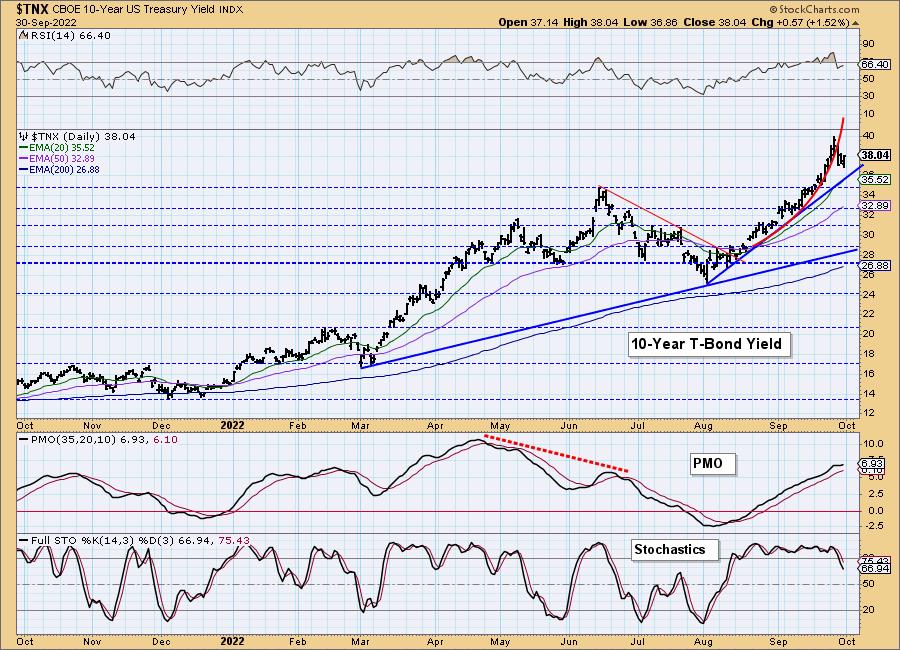
MORTGAGE INTEREST RATES (30-Yr)**
**We watch the 30-Year Fixed Mortgage Interest Rate, because, for the most part, people buy homes based upon the maximum monthly payment they can afford. As rates rise, a fixed monthly payment will carry a smaller mortgage amount. As buying power shrinks, home prices will come under pressure.
--
This week the 30-Year Fixed Rate rose from 6.29 to 6.70.
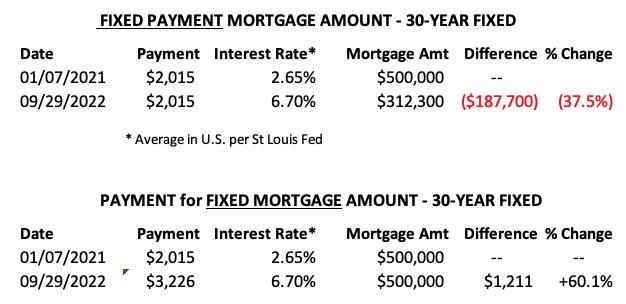
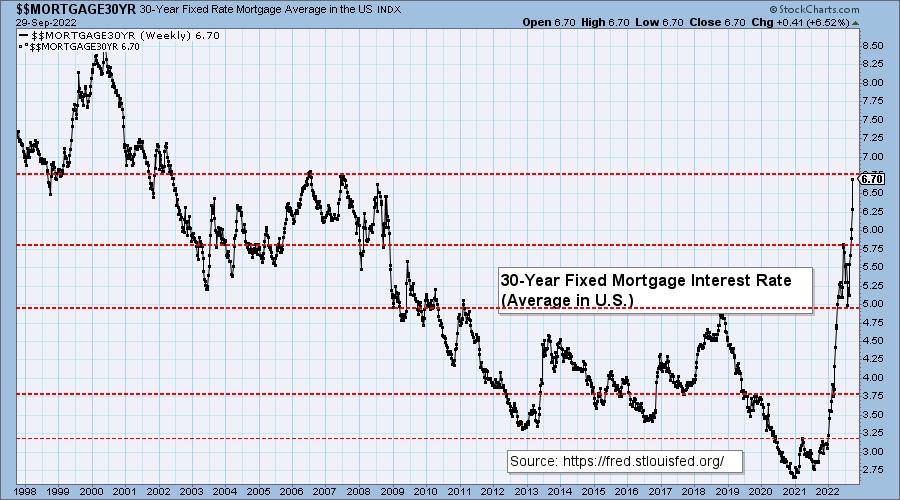
DOLLAR (UUP)
IT Trend Model: BUY as of 6/22/2021
LT Trend Model: BUY as of 8/19/2021
UUP Daily Chart: UUP also went parabolic and broke down this week. While the decline was steep, indicators aren't really that negative. The RSI is positive and while the PMO is flat. Stochastics aren't encouraging, nor is the bearish filled black candlestick. Seems the Dollar will test the 20-day EMA and rising bottoms trendline soon.
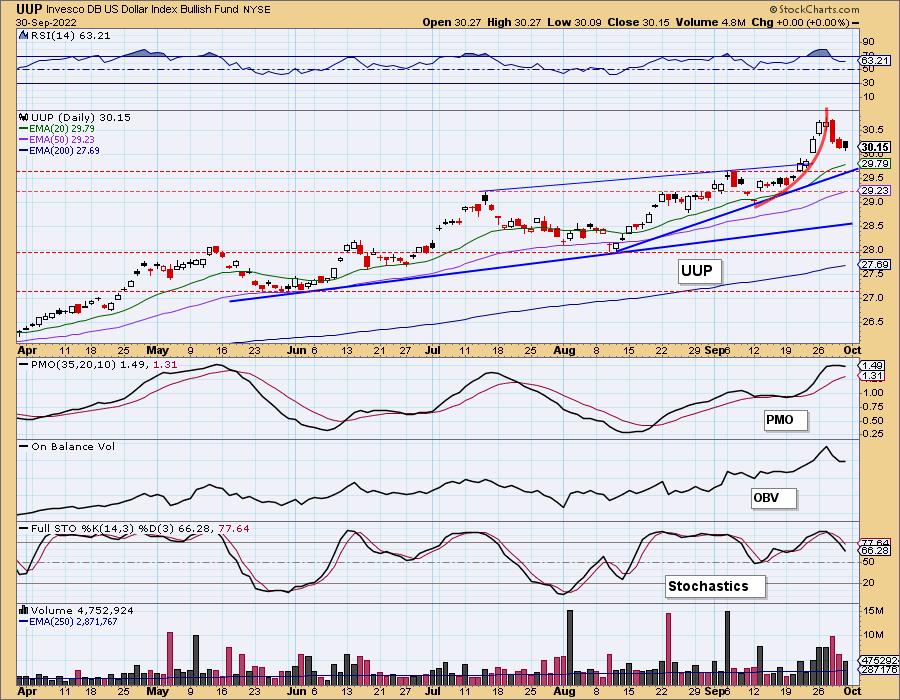
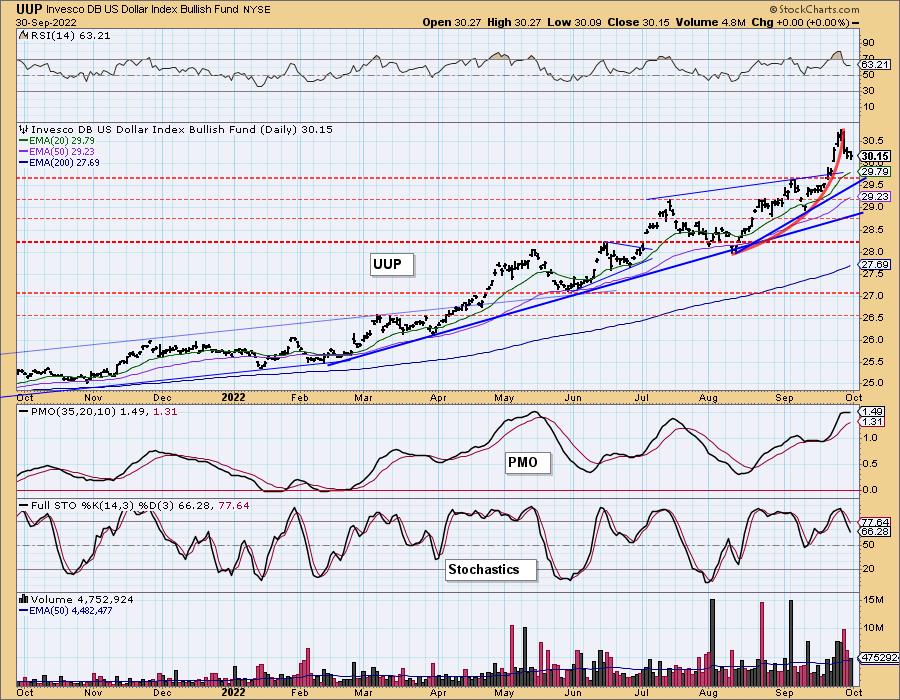
UUP Weekly Chart: The parabolic advance on the weekly chart continues to grow. The weekly chart is still quite positive, but remember, parabolic formations tend to breakdown quickly and painfully.
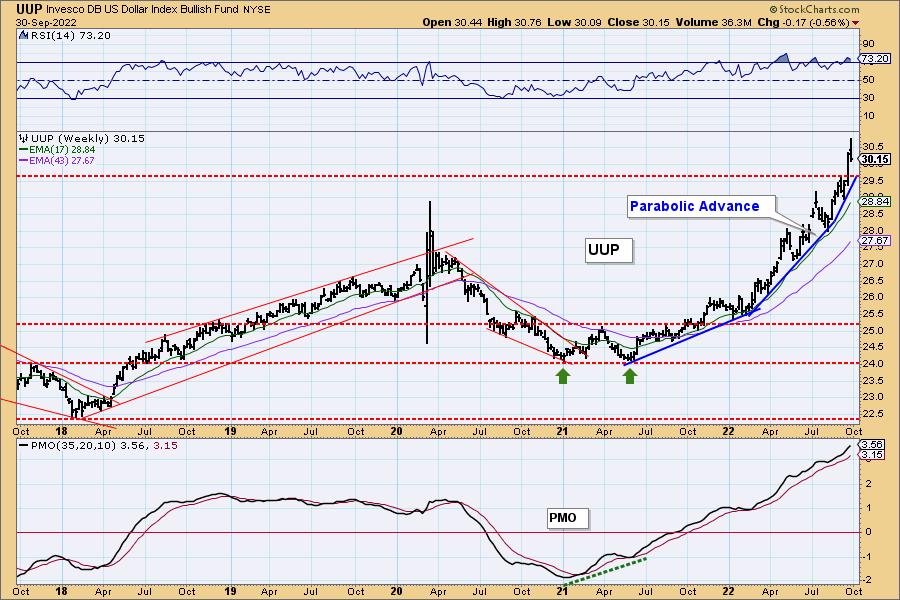
UUP Monthly Chart: There is a nearly vertical rising trend on the monthly chart. The monthly RSI and monthly PMO are rising strongly, but they are very overbought. The Dollar is due for a breakdown, but there just isn't any deterioration to be found on the weekly or monthly charts.
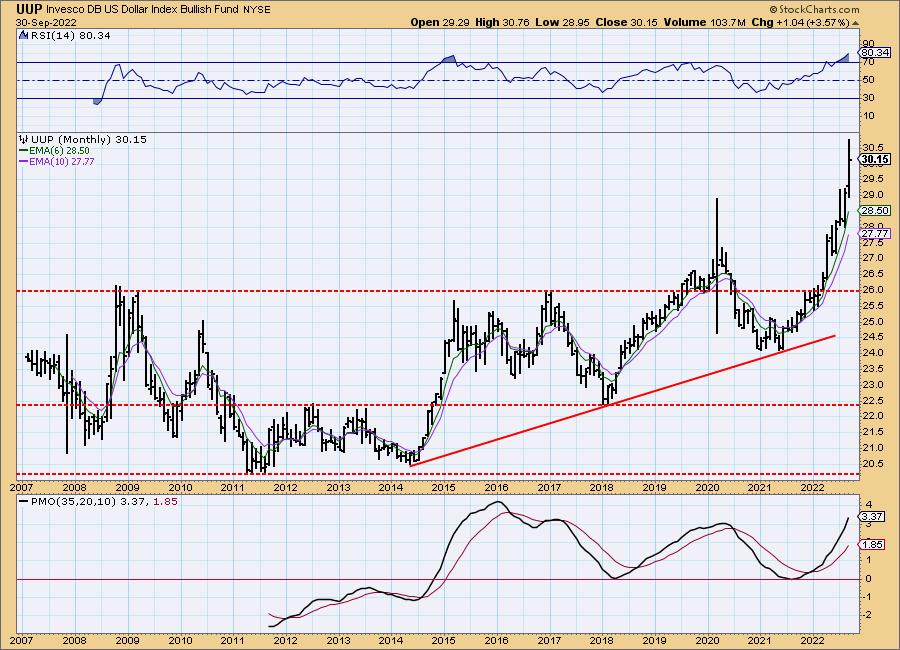
GOLD
IT Trend Model: NEUTRAL as of 5/3/2022
LT Trend Model: SELL as of 6/30/2022
GOLD Daily Chart: As it is with rising yields and Bonds, the rising Dollar is killing Gold. Every attempt to rally has been stymied. Still, the PMO and Stochastics are hinting that this rally could stick around.
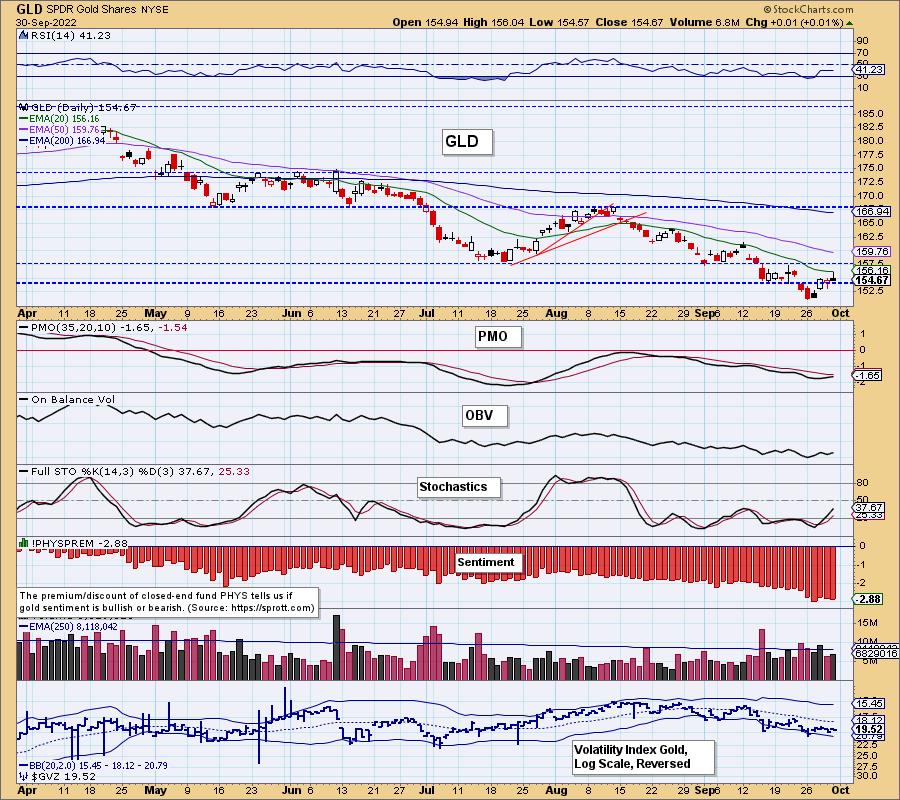
Today's discount reading is the third highest recorded since 2010. We have extraordinarily bearish sentiment. Sentiment is contrarian so we should see a rally continuation. However, these high discounts haven't translated into higher prices.
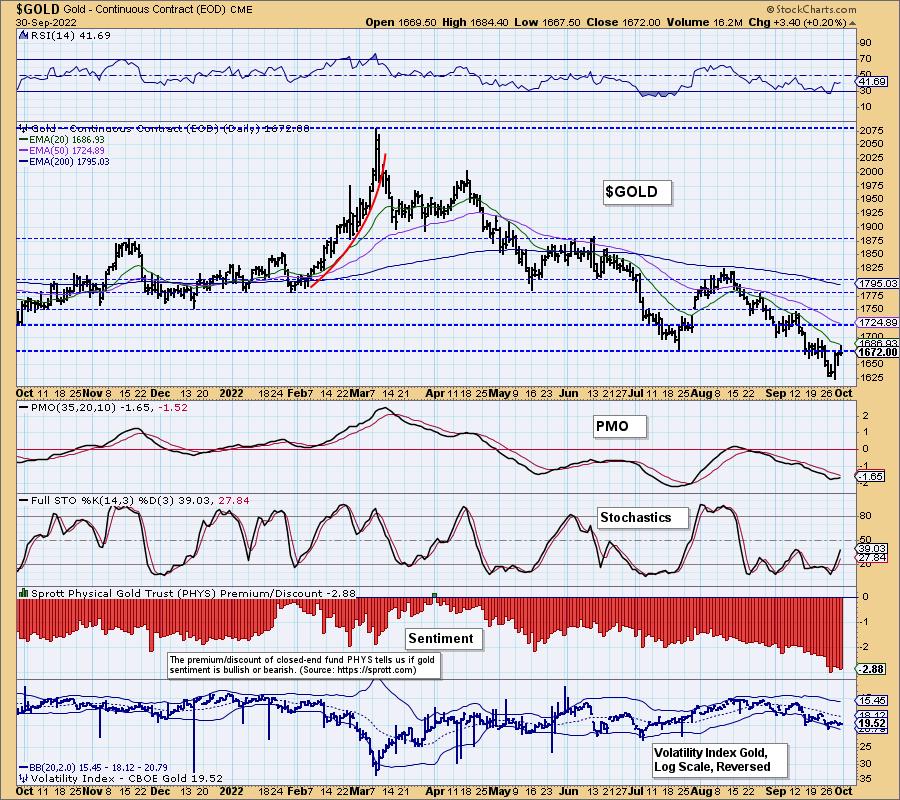
GOLD Weekly Chart: Gold has clearly broken the double top confirmation line, so the minimum downside projection is about 1250 based upon this weekly chart. Ouch.
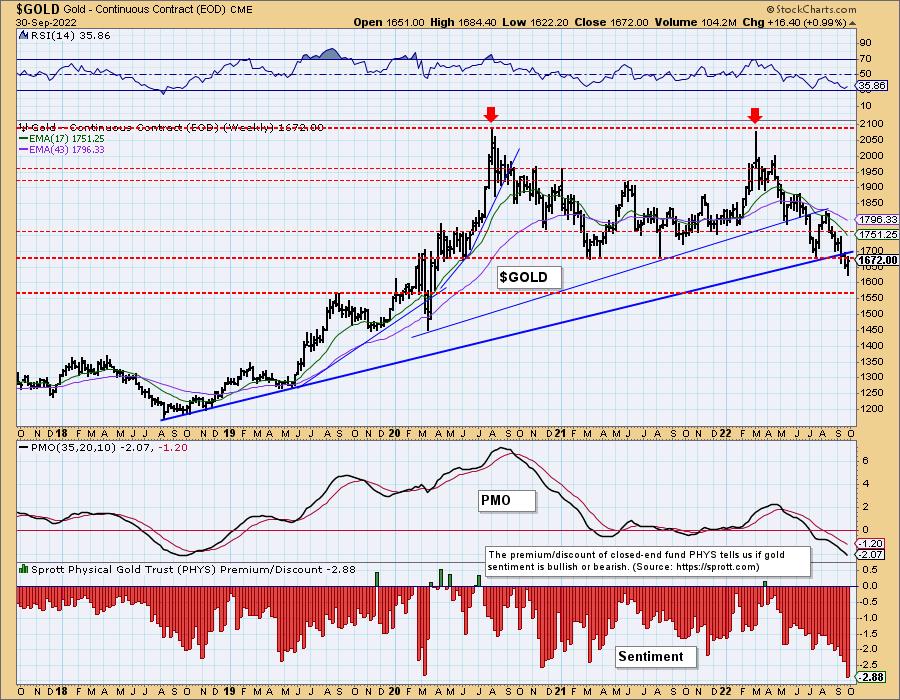
GOLD Monthly Chart: The monthly chart is somewhat more optimistic as it still shows a viable cup with handle formation. However, the monthly RSI is very negative and the monthly PMO is accelerating lower.
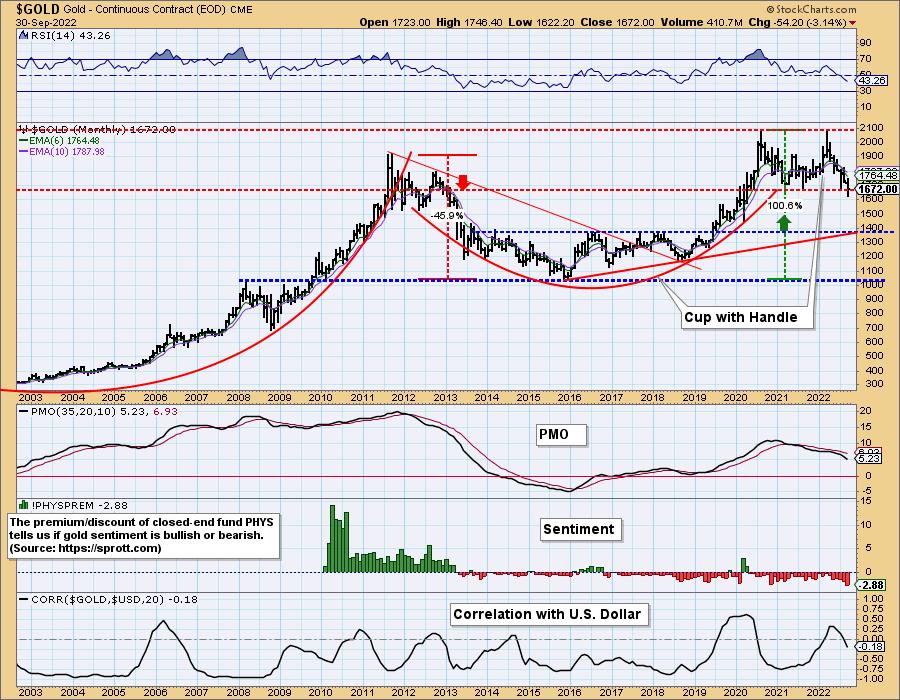
GOLD MINERS Golden and Silver Cross Indexes: GDX is coming back to life after breaking below support. This looks like a viable bottom given the RSI moved into positive territory and the PMO printed a crossover BUY signal today. We are cautious given indicators and participation are very similar to the last few price tops, but this is looking good for Miners.
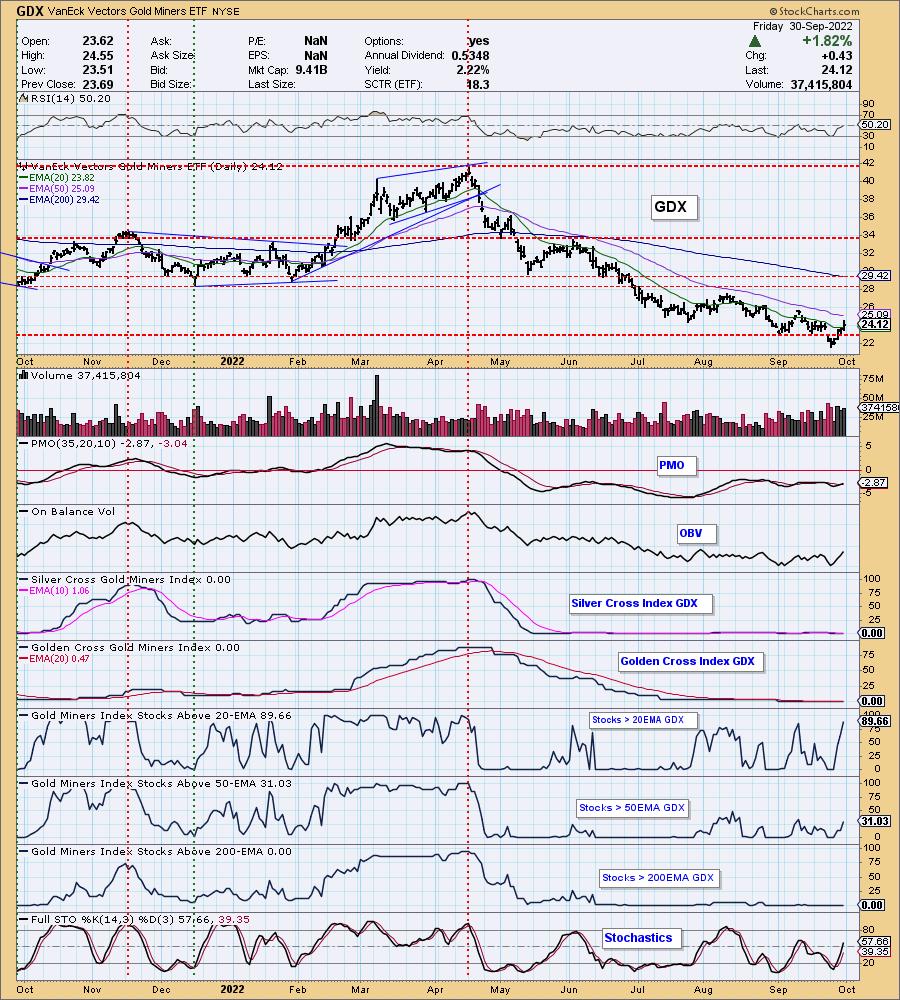
CRUDE OIL (USO)
IT Trend Model: NEUTRAL as of 7/8/2022
LT Trend Model: BUY as of 3/9/2021
USO Daily Chart: Crude Oil continues to meander downward. A bullish falling wedge developed this month but has yet to confirm with a breakout. Indicators are entirely unhelpful as they move sideways. If we look to the $OVX, it suggests internal weakness given the oscillation below its moving average on the inverted scale.
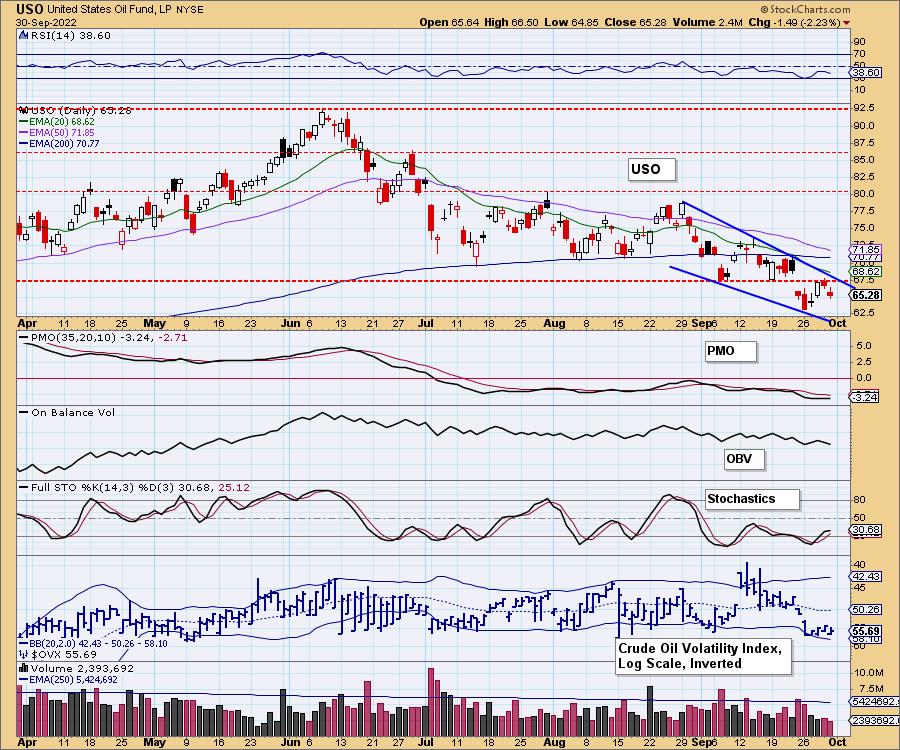
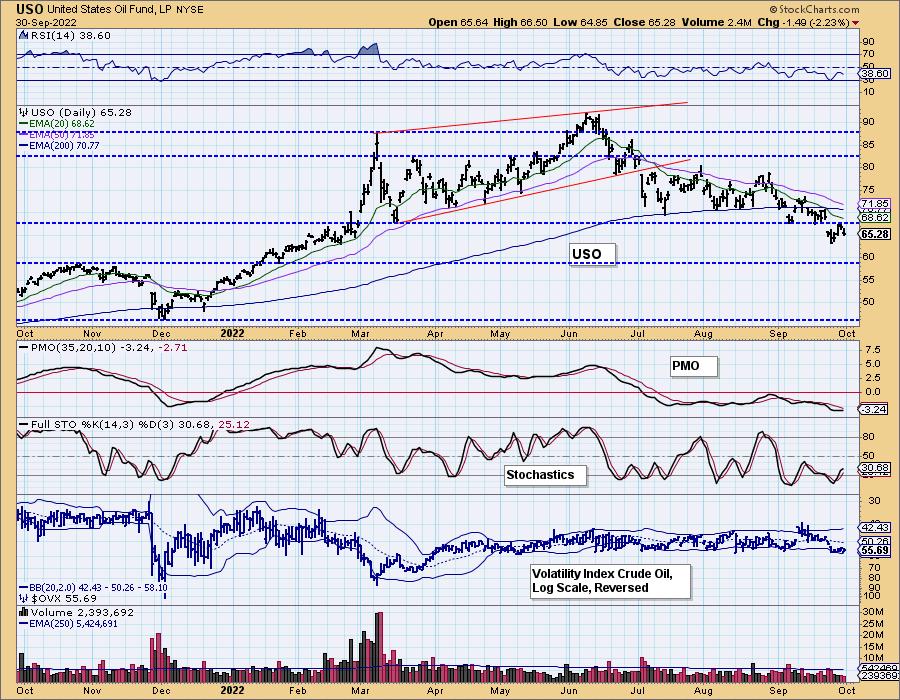
USO/$WTIC Weekly Chart: USO is nearing strong support at $60 and we expect it to hold there if it hasn't rebounded by then.
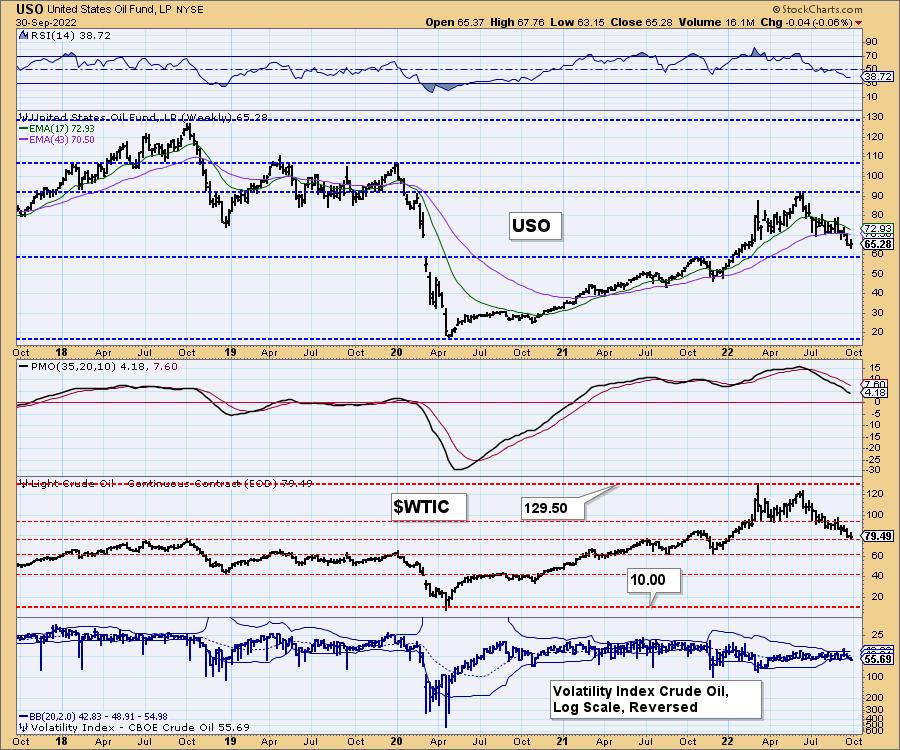
WTIC Monthly Chart: This current level of support has long-term implications as it aligns with the 2018 top. The monthly PMO is ugly as it tips over in highly overbought territory. The technicals suggest a breakdown ahead, but given the current global energy crisis and hurricane, supplies are still somewhat scarce. That nearly always leads to higher prices.
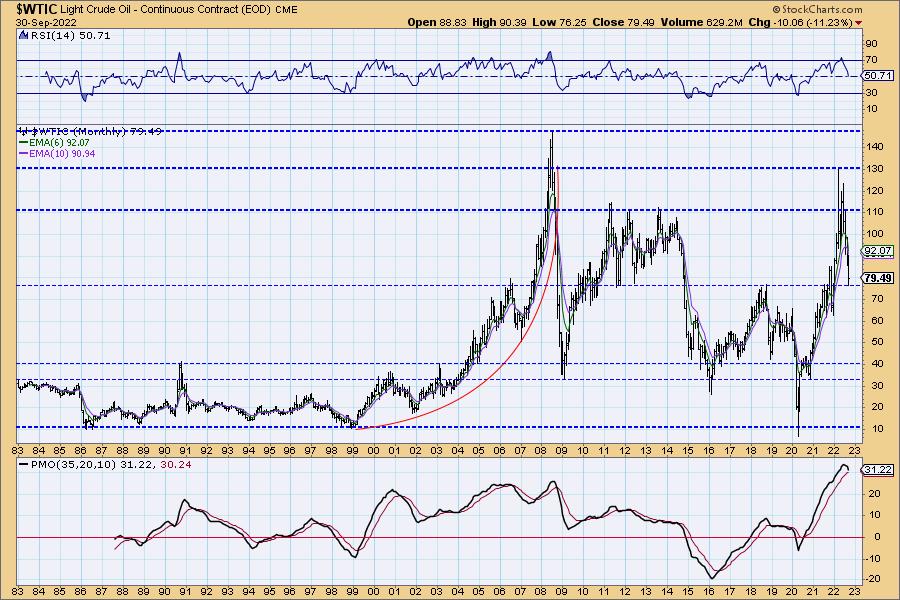
BONDS (TLT)
IT Trend Model: SELLas of 8/19/2022
LT Trend Model: SELL as of 1/19/2022
TLT Daily Chart: Big bearish engulfing candlestick on TLT today as it continues to get pummeled by rising yields. The RSI and PMO are very negative. While Stochastics are rising, they are already overbought in terms of the last few tops--certainly nothing to bank on.
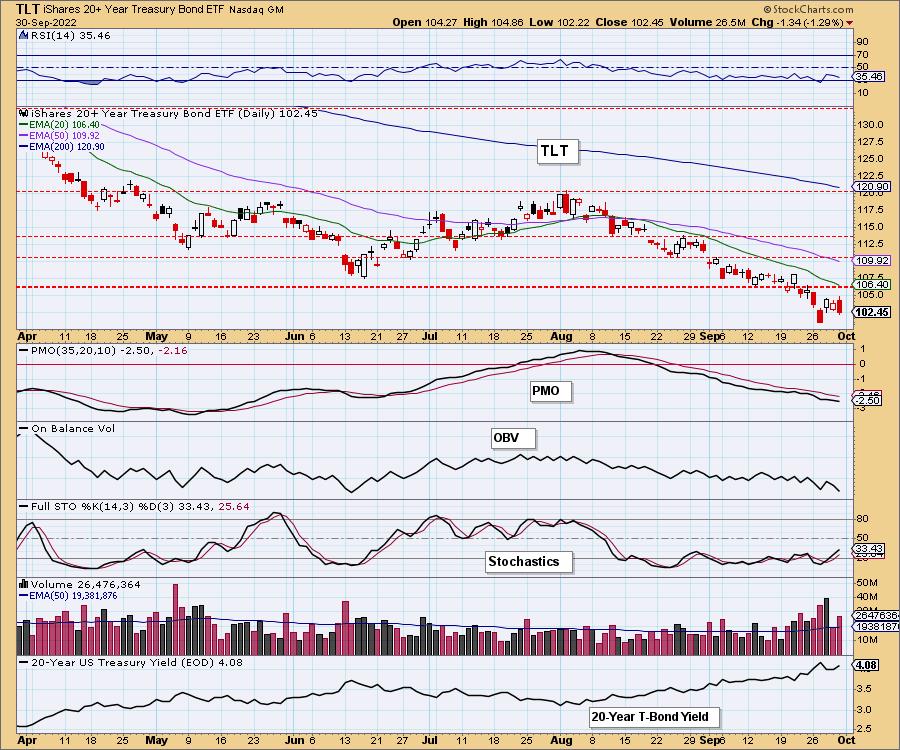
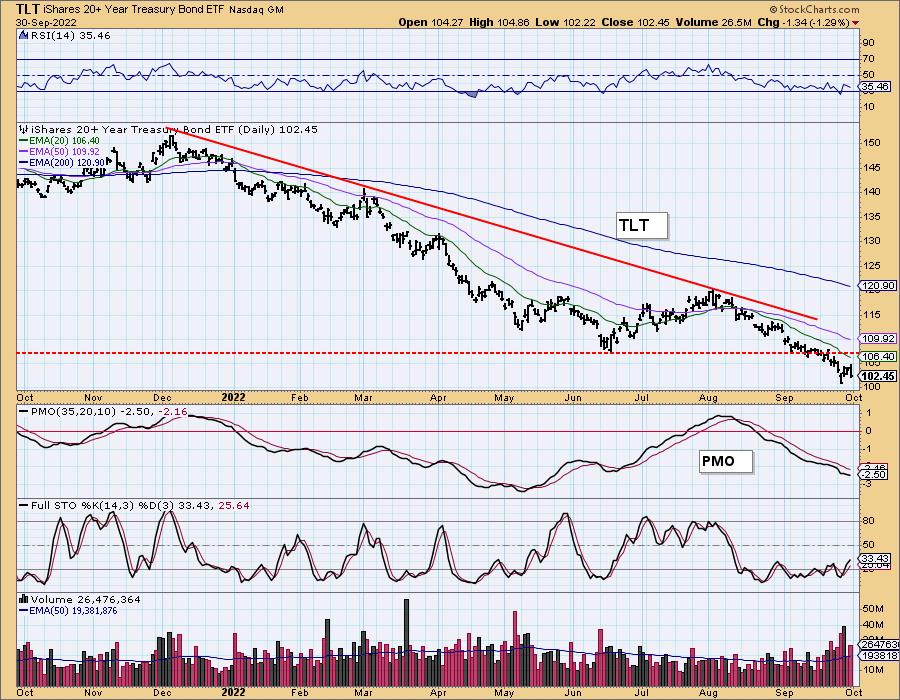
TLT Weekly Chart: This week price broke through the support zone between $104 and $105. The weekly RSI is oversold, as is the PMO, but both continue to decline.
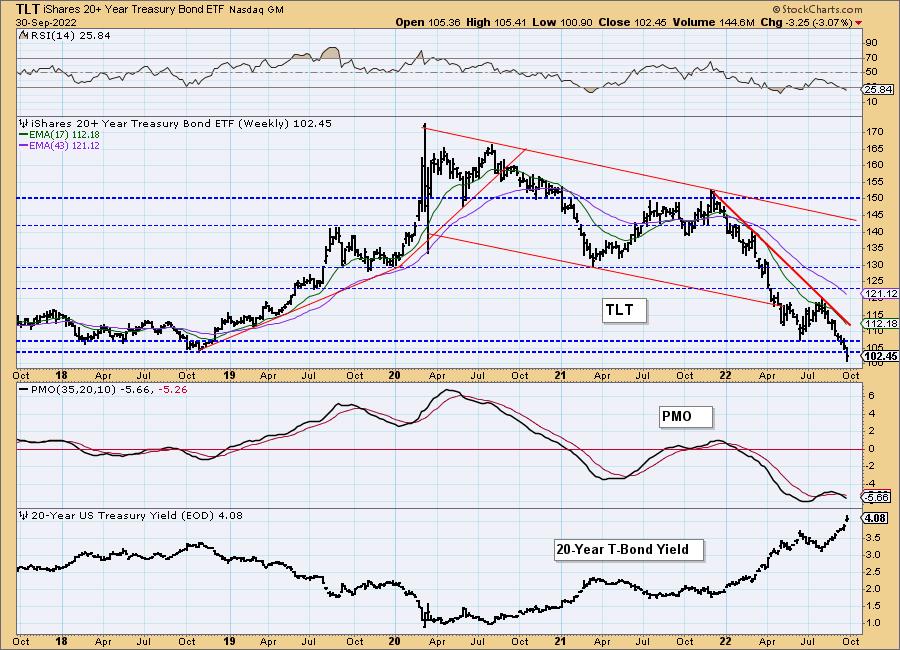
TLT Monthly Chart: This breakdown is serious as the multi-year rising trendline has been compromised along with support at 2016-2018 lows. Since tracking the monthly PMO, we see it is at its most oversold level, but is falling vertically. Not a good look for TLT.
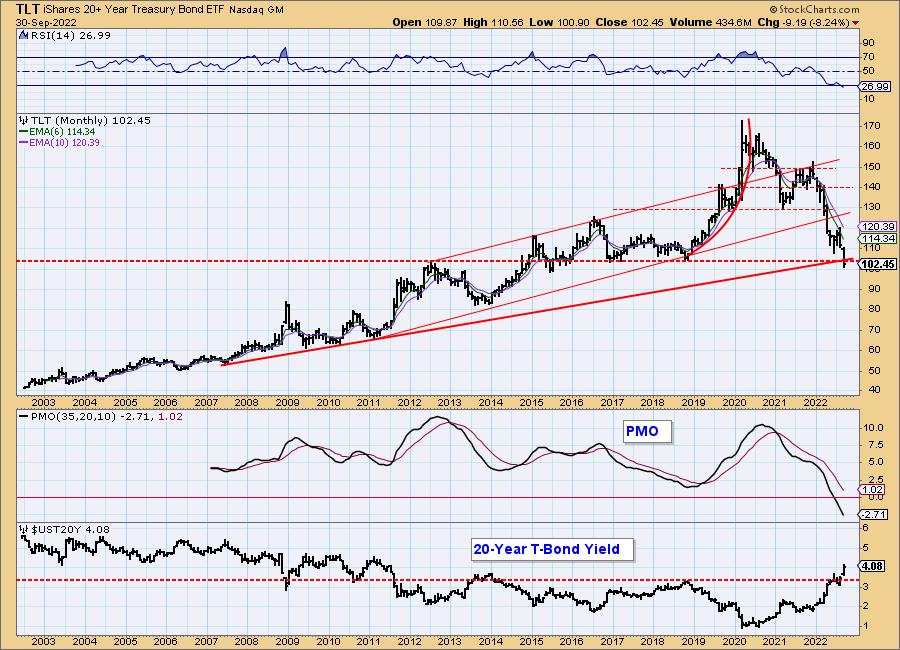
Good Luck & Good Trading!
Erin Swenlin And Carl Swenlin
Technical Analysis is a windsock, not a crystal ball. --Carl Swenlin
(c) Copyright 2022 DecisionPoint.com
Disclaimer: This blog is for educational purposes only and should not be construed as financial advice. The ideas and strategies should never be used without first assessing your own personal and financial situation, or without consulting a financial professional. Any opinions expressed herein are solely those of the author, and do not in any way represent the views or opinions of any other person or entity.
NOTE: The signal status reported herein is based upon mechanical trading model signals, specifically, the DecisionPoint Trend Model. They define the implied bias of the price index based upon moving average relationships, but they do not necessarily call for a specific action. They are information flags that should prompt chart review. Further, they do not call for continuous buying or selling during the life of the signal. For example, a BUY signal will probably (but not necessarily) return the best results if action is taken soon after the signal is generated. Additional opportunities for buying may be found as price zigzags higher, but the trader must look for optimum entry points. Conversely, exit points to preserve gains (or minimize losses) may be evident before the model mechanically closes the signal.
Helpful DecisionPoint Links:
DecisionPoint Alert Chart List
DecisionPoint Golden Cross/Silver Cross Index Chart List
DecisionPoint Sector Chart List
Price Momentum Oscillator (PMO)
Swenlin Trading Oscillators (STO-B and STO-V)
DecisionPoint is not a registered investment advisor. Investment and trading decisions are solely your responsibility. DecisionPoint newsletters, blogs or website materials should NOT be interpreted as a recommendation or solicitation to buy or sell any security or to take any specific action.
